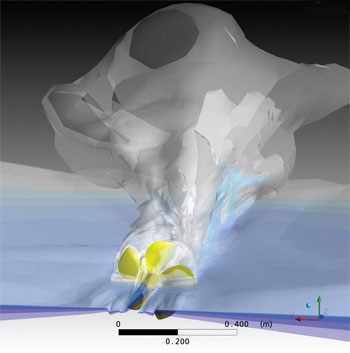Multiphase Flow
Multiphase flows are present in many industrial applications used by a variety of industries ranging from power generation to food and beverages. A multi-phase flow implies the simultaneous presence of two or more phases, that is, liquid, gaseous and/or solid.
Industrial Sectors Benefiting from Multiphase Flow Analysis
Among the industries and industrial applications that require multiphase flow analysis we can identify:
- Power generation: steam turbines, liquid, coal and biomass combustion and cavitation
- Automotive: fuel injection, SCR and FAP exhaust systems, condensed water disposal, de-icing and tank filling and sloshing
- Aerospace and Marine: fuel injection, atomization, free surface flows, sloshing and particle transport
- Chemical and process industry: abatement, filtration and separation systems, scrubbers, mixers, particle transport, fluid-beds, erosion, deposition, bubbly flows, slug catchers
- Environmental: wave breaking, tide, tsunamis, particle dispersion
- Food & beverage and bio-technology: filling and packaging, drying processes
Engineering Simulation applied to Multiphase Flows

A multiphase simulation requires specific numerical models to accurately simulate the interaction between different phases. The two most commonly used modelling techniques are:
- Eulerian-Eulerian which is typically used in the study of dense dispersed systems
- Eulerian-Lagrangian, more suitable for particle transport cases
Both techniques take into account the interaction of phases in terms of momentum, heat, turbulence and mass exchange.
Some of the physics that a numerical model should be able to capture include:
- drag calculation
- bubbly regimes, poly-dispersed fluids
- free surface flows
- surface tension and wall adhesion, capillarity
- particle transport
- liquid sprays, atomization, primary and secondary break-up
- thermal phase change, evaporation, gasification
- cavitations
- immiscible liquids
Why is Multiphase Flow Analysis so important?
Multiphase simulation provides an advanced numerical tool that is able to obtain qualitative and quantitative information about complex flows. It gives a deep insight into phenomena that are hardly observable or measurable. Some of the advantages that can be derived from multiphase flow simulation are:
- higher energy efficiency (e.g. by improving the fuel injection systems in the aero, auto and power generation sectors)
- reduced emissions (e.g. by increasing the efficiency of filtration, separation and abatement systems)
- improved production (e.g. by increasing mixing in process columns, reactors, mixers, and increasing efficiency for hydraulic and steam turbines)
- improved performance (e.g. by decreasing drag in marine applications)
- longer life for pumps, valves and other devices thanks to reduced cavitations
- increased security thanks to particle transport prediction in the case of large-scale industrial accidents and tsunamis
